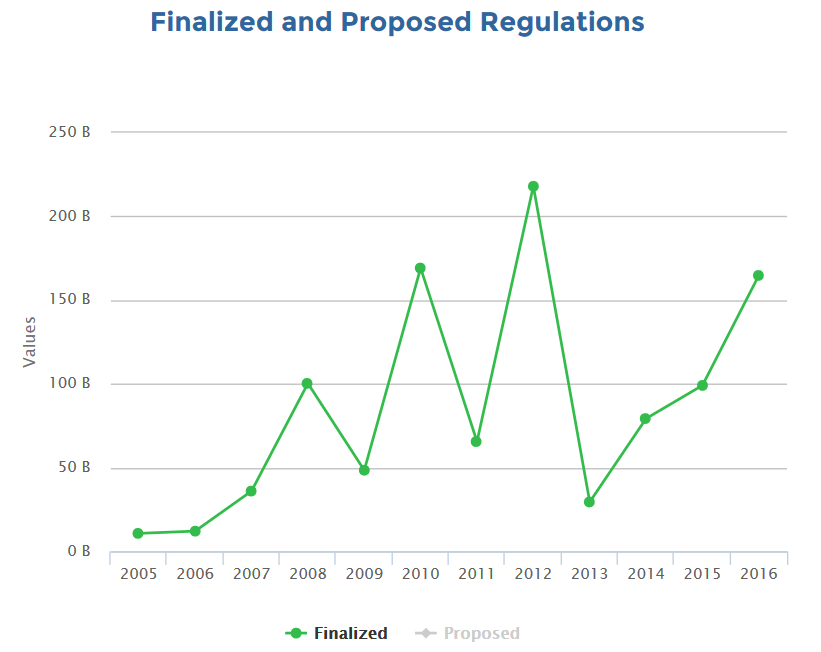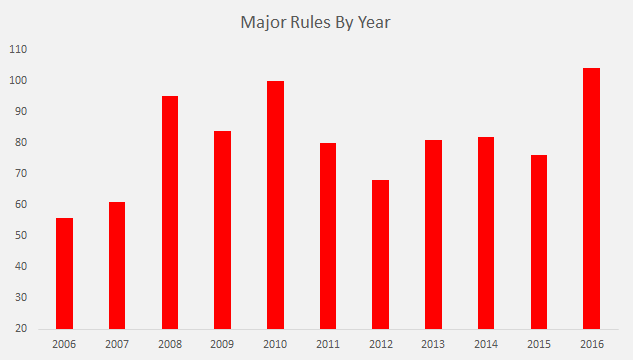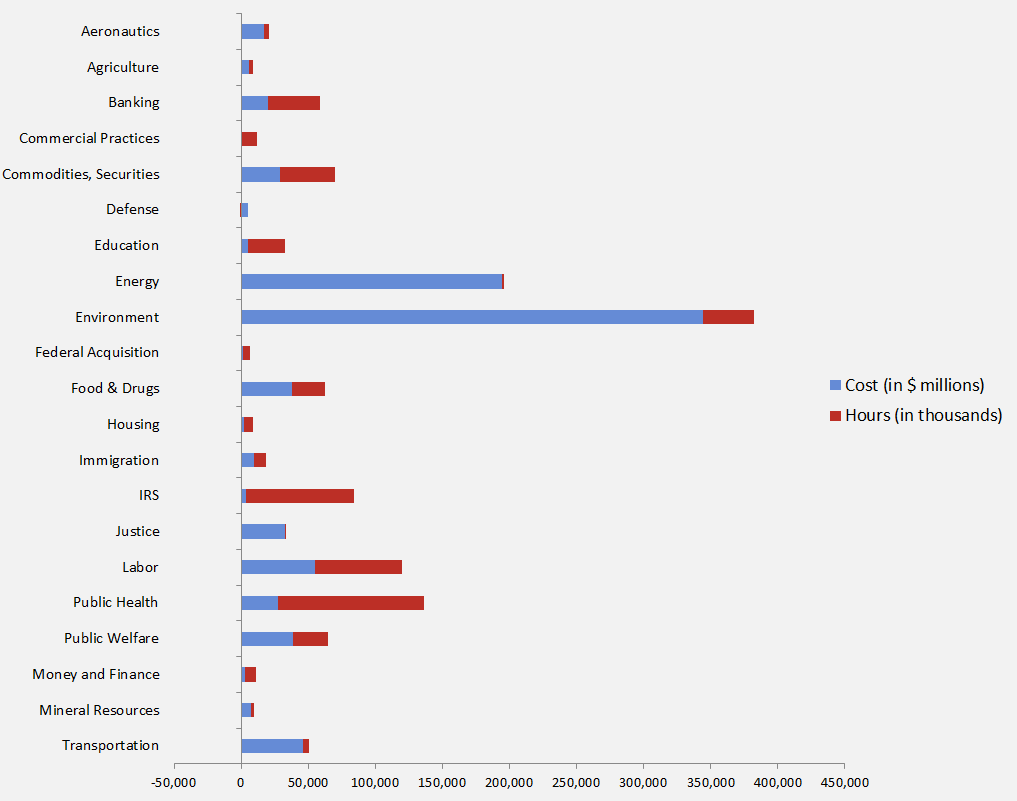Insight
February 2, 2017
Midnight Regulations Push Obama Administration’s Regulatory Tally Past $890 Billion
With a last-minute flourish of $24 billion in final regulatory costs in the last three weeks, the Obama Administration passed $890 billion in cumulative burdens. The record-breaking regulatory output of 2016, which imposed the most major rules in history, capped perhaps the most aggressive regulatory record in history. From the available data on the American Action Forum’s (AAF) RegRodeo.com, the Bush Administration averaged $42 billion in annual final rule costs. The Obama Administration more than doubled that figure, with $111 billion in annual final burdens. For perspective, during the last four years of the Bush Administration, it imposed more than $159 billion in burdens; President Obama and his regulators published $218 billion in 2012 alone and another $164 billion in 2016.
The graph below charts the growth of federal regulatory costs from 2005 to 2016.
Below are the highlights of total final regulatory costs and annual figures on costs, paperwork, and benefits.
- Total Costs: $890 billion
- Annual Costs: $139 billion
- Annual Paperwork: 549 million hours
- Annual Benefits: $454 billion
- Billion-Dollar Rules: 113
For perspective on annual costs, the administration imposed more than $139 billion or roughly $429 per person in the U.S. Regulators often concede that new federal rules can decrease employment, raise prices, and there is some evidence regulation can also result in lower worker pay. The costs of these $890 billion in burdens must be borne by someone and it is the American people who inevitably end up paying for these rules in some form.
When the federal government raised income and various other taxes in 2013, it was assumed those higher levies would have an impact on aggregate economic growth. Those tax hikes amounted to roughly $40 billion annually; President Obama’s regulatory imposition is more than three times that on an annual basis. The effects of these rules might not often be apparent, but the costs are significant and are felt at all levels of the economy, from the small business employee with more expensive health insurance to the power plant employee now without gainful employment.
By Agency
The following table displays regulatory costs during the Obama Administration from all agencies with more than one billion in regulatory costs (sorted alphabetically).
| Agency | Cost | Paperwork Hours |
| Agriculture | $5.7 billion | -3.6 million |
| Consumer Financial Protection Bureau | $2.8 billion | 17 million |
| Commodity Futures Trading Commission | $8.9 billion | 15.9 million |
| Defense | $3.3 billion | 7.7 million |
| Education | $5.2 billion | 27.5 million |
| Energy | $194 billion | 1.4 million |
| Environmental Protection Agency | $344 billion | 36.7 million |
| Health and Human Services | $104 billion | 158 million |
| Homeland Security | $17 billion | 9.6 million |
| Interior | $7.7 billion | 2.2 million |
| Justice | $33 billion | 919,000 |
| Labor | $56 billion | 69 million |
| Securities and Exchange Commission | $18 billion | 23.8 million |
| Transportation | $58 billion | -16.4 million |
| Treasury | $21 billion | 90 million |
Number one on this list will surprise few: the Environmental Protection Agency (EPA). At $344 billion, it easily outpaces the next-closed agency, the Department of Energy ($194 billion). EPA’s largest regulations were efficiency rules that were frequently the target of intense scrutiny among special interests and Capitol Hill, although less so than its controversial power plant rules. In fact, by total costs the agency’s three largest rules were efficiency standards for light-duty and heavy-duty vehicles. The “Clean Power Plan” (CPP) actually ranks sixth by total costs.
The second-most active agency, DOE, often operated under the radar, at least compared to the EPA. However, at $194 billion in total costs, DOE frequently imposed more costs in one year during the Obama Administration than the Bush Administration did in its second term. The largest DOE rule was a 2011 rule that established new efficiency standards for refrigerators, at $27.3 billion in long-term burdens. The extent of DOE’s regulatory pace during the last eight years cannot be overstated. From 1993 to early 2009, the agency published ten “economically significant” regulations. The Obama Administration managed to approve 36 significant DOE measures, more than triple the output from the previous two administrations.
The Department of Health and Human Services (HHS) rounds out one of the three agencies that imposed more than $100 billion in total burdens. Given the task of implementing the Affordable Care Act, it is not surprising that HHS was busy during the last eight years. For perspective, the Bush Administration published 116 significant HHS rules. By contrast, the Obama Administration approved 168, or 44 percent more. One of the largest HHS measures implemented the exchanges and amended Medicaid standards in 2013, with $5.2 billion in costs and 12.8 million paperwork burden hours. A Food & Drug Administration measure banning trans fats also imposed notable costs, at $11 billion, although the high-end benefits eclipse costs by 40:1.
Largest Rules
Often in regulation, the burdens are top-heavy, with a few rules imposing a large percentage of costs. Below are the ten largest rules from the Obama Administration, by annual costs:
- 2017-2025 CAFE Standards: $10.8 billion
- Mercury Standards for Coal: $9.6 billion
- Clean Power Plan: $8.4 billion
- 2012-2016 CAFE Standards: $4.9 billion
- Volcker Rule: $4.3 billion
- Liquidity Risk Measurement Standards: $3.6 billion
- Phase 2: GHG Standards for Trucks: $2.5 billion
- Margin Requirements for Uncleared Swaps: $2 billion
- Fiduciary Rule: $1.9 billion
- Joint Industry Plan: $1.7 billion
Combined, these rules will impose nearly $50 billion in annual burdens, or more than one-third of all burdens from the past eight years. Five of the above rules are courtesy of EPA and the remainder are financial services rules.
In terms of major regulation, the Obama Administration is in a class by itself. From the Government Accountability Office’s (GAO) available data, the Clinton Administration averaged 71 major rules annually; President Bush averaged 62 major rules. Although the count is not yet complete, President Obama will average at least 83 major rules annually, 18 percent more than President Clinton and 33 percent more than President Bush. The Obama Administration also set records in 2010 (100 major rules) and 2016 (104 major rules) for major regulation. The graph below depicts major rule output from 2006 to 2016.
Benefits
Typically, regulations imposing the highest costs also generate significant benefits. This is especially true for energy and environmental rules. For example, EPA’s Cross-State Air Pollution Rule (CSAPR) imposed approximately $800 million in burdens, but benefits range from $110 billion to $280 billion annually, driven largely by reductions in fine particulate matter and ozone. Combined, the administration published $458 billion in annual regulatory benefits. Below are the rules with the largest listed benefits.
- CSAPR: $69.8 billion
- Mercury Air Toxics Standard: $57 billion
- Clean Power Plan: $42 billion
- 2017-2025 Vehicle Efficiency Standards: $35.2 billion
- Boiler MACT: $25 billion
Deregulatory Efforts and Executive Order 13563
In 2011, President Obama issued an executive order aimed at modifying, streamlining, expanding, and repealing existing regulations. As AAF documented frequently, regulators often expanded previous rules and amended or repealed them less often. For instance, despite deregulatory measures that cut costs, the administration still managed to add more than $890 billion in net burdens.
AAF recorded $26.8 billion in cost-cutting regulations since President Obama’s executive order on reform and $7.6 billion in annual savings. The administration provided estimates slightly higher than those. These deregulatory efforts are commendable, but there are three other Obama-era rules that impose more than $7.6 billion in costs alone. Frequently, the administration would label regulations needed to implement the Affordable Care Act or environmental standards as retrospective, even though they are implementing new standards that add burdens. For example, the most expensive regulation from the administration, CAFE standards, was listed as a retrospective review. If a $10 billion rule implementing tighter standards constitutes retrospective review, then virtually every new measure should be considered retrospective. Due to the uneven nature of the president’s efforts, this attempt to reduce regulatory burdens was largely a failure.
State Impacts
When regulators publish their analysis of rules, they often list the affected industries. For example, when DOE listed its HVAC efficiency standards, it listed “Air-Conditioning and Warm Air Heating Equipment and Commercial and Industrial Refrigeration Equipment Manufacturing” as the affected industry. Census data detailing the geographic distribution of industries nationwide allows AAF to apportion illustrative regulatory burdens by state. The map below represents the cost distribution of the largest final rules from the Obama Administration.
By Industry
When agencies release rules, they designate where in the Code of Federal Regulations (CFR) the regulations will be codified. For example, environmental rules are in Title 40 of the CFR and efficiency standards are in title 10. With this data, AAF can display regulatory burdens by industry or subject matter, from agriculture to transportation. The graph below depicts regulatory costs in blue, with new paperwork in red. Anything to the right represents net costs and anything to the left depicts fewer burdens.
Notice the significant spike from both “Environment” and “Energy.” This reflects activity from EPA and DOE, with Environment adding nearly 38 million hours of federal paperwork. Combined, Environment and Energy added more than $538 billion in costs. HHS typically regulates “Public Health” and “Public Welfare” and those two areas added $65.7 billion in costs and 172 million paperwork hours. “IRS” makes a notable appearance above, but only for its 80 million new hours of paperwork; the agency rarely monetizes the cost of hourly burdens.
Conclusion
During the past eight years, regulators imposed energy rules to address climate change and made fundamental changes to the health care, financial services, and telecommunications industries. The imposition of $890 billion in burdens shouldn’t surprise many, given the policies of the administration and its desire to change so many industries at once. The true effects of these regulatory costs will be felt for years and many have already imposed sunk costs, making repeal a hollow victory. The records of the Obama Administration will soon face a determined Congress and new president willing to scrutinize and amend many of the most controversial regulations from the last eight years.













